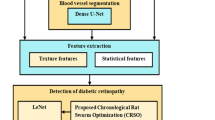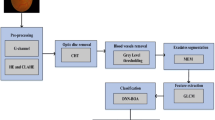Abstract
Diabetic patients are tremendously increasing worldwide and it is a chronic disease that may cause complications in Eye, Heart, and Kidneys. Diabetic retinopathy (DR) plays a vital role that causing vision loss in diabetic patients, if not treated at an earlier stage. Nowadays, a lot of patients undergo eye screening per day, therefore ophthalmologists face a lot of challenges during the screening of Diabetic retinopathy. Also, manual screening leads to errors and is more time-consuming, the patients have to wait for much time in the clinic. Hence an automated system is essential to help the ophthalmologist as a secondary opinion in retinal screening. Normally, clinicians will detect the different signs of DR from the retinal images taken through fundus photography, may leads manual error. Here, this research work proposes a novel automated system through the implementation of deep learning techniques in biomedical analysis. This system includes the following stages pre-processing, segmentation, and classification. For analysis, the proposed research article work on retina fundus images is taken from the both Public dataset and the in-house clinical dataset from Chaithanya Eye Hospital Kerala. The first stage is to remove noise from the input image and enhance the contrast of the images. For noise reduction, a Bilateral Filter is utilized first, followed by enhancement utilizing Contrast Limited Adaptive Histogram Equalization with an unsharp technique. Then Thick Blood vessels are segmented from the enhanced image using the Extended Iterative Self-Organizing clustering (EISOC) Method. From the segmented image, GLCM features are extracted and then features are selected using the Improved Fractional-Order Darwinian Particle Swarm Optimization (IFODPSO) technique. Finally, a Deep CNN classifier is used which classifies the image as Diabetic Retinopathy (DR) or Normal case. Using IFODPSO with a DCNN classifier, 96.6% of the predictions are correct, 3.4% are wrong and the parameter such as Sensitivity is 92.5%, Specificity is 98.9%, Precision is 95.9% values are obtained. By way of classifier efficiency estimation, IFODPSO with DCNN classifier is higher than most other standard classifiers in the literature.









Similar content being viewed by others
Data availability
Not applicable.
References
Gu K, Zhai G, Yang X, Zhang W (2015) Deep learning network for blind image quality assessment. 2014 IEEE International Conference on Image Processing, ICIP 2014. 511–515. https://doi.org/10.1109/ICIP.2014.7025102
Wang GG, Deb S, Cui ZH (2015) Monarch Butterfly Optimization. Neural Comput Appl. https://doi.org/10.1007/s00521-015-1923-y
Wong RL, Singh SR, Rasheed MA, Goud A, Chhablani G, Samantaray S, AnkiReddy S, Vupparaboina KK, Chhablani J (2021) En-face choroidal vascularity in central serous chorioretinopathy. Eur J Ophthalmol 31(2):536–542. https://doi.org/10.1177/1120672120908719
Toto L, D’Aloisio R, Mastropasqua R, Di Antonio L, Di Nicola M, Di Martino G, Evangelista F, Erroi E, Doronzo E, Mariotti C (2019) Anatomical and Functional Changes of the Retina and the Choroid after Resolved Chronic CSCR. J Clin Med 8:474. https://doi.org/10.3390/jcm8040474
Sahoo M, Pal S, Mitra M (2017) Automatic segmentation of accumulated fluid inside the retinal layers from optical coherence tomography images. Measurement 101:138–144. https://doi.org/10.1016/j.measurement.2017.01.027
Alyoubi WL, Abulkhair MF, Shalash WM (2021) Diabetic Retinopathy Fundus Image Classification and Lesions Localization System Using Deep Learning. Sensors 21(11):3704. https://doi.org/10.3390/s21113704
He A, Li T, Li N, Wang K, Fu H (2021) CABNet: category attention block for imbalanced diabetic retinopathy grading. IEEE Trans Med Imaging 40(1):143–153. https://doi.org/10.1109/TMI.2020.3023463
Li T, Gao Y, Wang K, Guo S, Liu H, Kang H (2019) Diagnostic assessment of deep learning algorithms for diabetic retinopathy screening. Inf Sci 501:511–522
Albert Jerome S, Vijila Rani K, Mithra KS, Eugine Prince M (2021) Watershed segmentation with CAFIS and RCNN classification for pulmonary nodule detection. IETE J Res. https://doi.org/10.1080/03772063.2021.1978876
Wang J, Luo J, Liu B, Feng R, Lu L, Zou H (2020) Automated diabetic retinopathy grading and lesion detection based on the modified R-FCN object-detection algorithm. IET Comput Vision 14(1):1–8. https://doi.org/10.1049/iet-cvi.2018.5508
Tsiknakis N, Theodoropoulos D, Manikis G, Ktistakis E, Boutsora O, Berto A, Scarpa F, Scarpa A, Fotiadis DI, Marias K (2021) Deep learning for diabetic retinopathy detection and classification based on fundus images: A review. Comput Biol Med 135:104599. https://doi.org/10.1016/j.compbiomed.2021.104599
Rani KV, Jawhar SJ (2020) Automatic segmentation and classification of lung tumour using advance sequential minimal optimisation techniques. IET Image Proc 14(14):3355–3365. https://doi.org/10.1049/iet-ipr.2020.0407
Butt MM, Iskandar DNFA, Abdelhamid SE, Latif G, Alghazo R (2022) Diabetic retinopathy detection from fundus images of the eye using hybrid deep learning features. Diagnostics (Basel) 12(7):1607. https://doi.org/10.3390/diagnostics12071607
Tillett J, Rao TM, Sahin F, Rao R, Brockport S (2005) Darwinian Particle Swarm Optimization. In Proceedings of the 2nd Indian International Conference on Artificial Intelligence, pp. 1474–1487
Rani KV, Jawhar SJ (2021) Novel technology for lung tumor detection using nanoimage. IETE J Res 67(5):699–713
Sheela Shiney TS, Jemila Rose R (2021) Deep auto encoder based extreme learning system for automatic segmentation of cervical cells. IETE J Res 1–21. https://doi.org/10.1080/03772063.2021.1958075
Khan KB, Siddique MS, Ahmad M, Mazzara M (2020) A hybrid unsupervised approach for retinal vessel segmentation. Biomed Res Int 2020:8365783. https://doi.org/10.1155/2020/8365783
Vijila Rani K, Joseph Jawhar S, Palani Kumar S (2020) Nanoscale imaging technique for accurate identification of brain tumor contour using NBDS method. J Ambient Intell Humanized Comput. https://doi.org/10.1007/s12652-020-02485-y,pp1-162020
Aziz T, Charoenlarpnopparut C, Mahapakulchai S (2023) Deep learning-based hemorrhage detection for diabetic retinopathy screening. Sci Rep 13(1):1–12. https://doi.org/10.1038/s41598-023-28680-3
Oh K, Kang HM, Leem D, Lee H, Seo KY, Yoon S (2021) Early detection of diabetic retinopathy based on deep learning and ultra-wide-field fundus images. Sci Rep 11(1):1–9. https://doi.org/10.1038/s41598-021-81539-3
Rani KV, Sumathy G, Shoba LK et al (2023) Radon transform-based improved single seeded region growing segmentation for lung cancer detection using AMPWSVM classification approach. SIViP 17:4571–4580. https://doi.org/10.1007/s11760-023-02693-x
Li Y-H, Yeh N-N, Chen S-J, Chung Y-C (2019) Computer –assisted diagnosis for diabetic retinopathy based on fundus images for deep convolutional neural network. Mob Inf Syst 2019:1–14. https://doi.org/10.1155/2019/6142839
Ting DSW, Pasquale LR, Peng L, Campbell JP, Lee AY, Raman R, Tan GSW, Schmetterer L, Keane PA, Wong TY (2019) Artificial intelligence and deep learning in ophthalmology. Br J Ophthalmol 103(2):167–175. https://doi.org/10.1136/bjophthalmol-2018-313173
Mei Zhou M, Jin K, Wang S, Ye J, Qian D (2018) Color retinal image enhancement based on luminosity and contrast adjustment. IEEE Trans Biomed Eng 65(3):521–527. https://doi.org/10.1109/TBME.2017.2700627
Vijila Rani K, Joseph Jawhar S (2022) Lung lesion classification scheme using optimization techniques and hybrid (KNN-SVM) classifier. IETE J Res 68(2):1485–1499. https://doi.org/10.1080/03772063.2019.1654935
Saha R, Chowdhury AR, Banerjee S (2016) diabetic retinopathy related lesions detection and classifications using machine learning technology. Springer Int Publ, Switzerland, Part- II, LNAI 9693:734–745. https://doi.org/10.1007/978-3-319-39384-1_65
Srivastava R, Duan L, Wong DW, Liu J, Wong TY (2017) Detecting retinal microaneurysms and hemorrhages with robustness to the presence of blood vessels. Comput Methods Programs Biomed 138:83–91. https://doi.org/10.1016/j.cmpb.2016.10.017
Adal KM, Sidibé D, Ali S, Chaum E, Karnowski TP, Mériaudeau F (2014) Automated detection of microaneurysms using scale-adapted blob analysis and semi-supervised learning. Comput Methods Programs Biomed 114(1):1–10. https://doi.org/10.1016/j.cmpb.2013.12.009
Akram MU, Khalid S, Khan SA (2012) Identification and classification of microaneurysms for early detection of diabetic retinopathy. Pattern Recogn 46(1):107–116. https://doi.org/10.1016/j.patcog.2012.07.002
Abràmoff MD, Reinhardt JM, Russell SR, Folk JC, Mahajan VB, Niemeijer M, Quellec G (2010) Automated early detection of diabetic retinopathy. Ophthalmology 117(6):1147–1154. https://doi.org/10.1016/j.ophtha.2010.03.046
Malhi A, Grewal R, Pannu HS (2023) Detection and diabetic retinopathy grading using digital retinal images. Int J Intell Robot Appl 7:426–458. https://doi.org/10.1007/s41315-022-00269-5
Bajwa A, Nosheen N, Talpur KI, Akram S (2023) A prospective study on diabetic retinopathy detection based on modify convolutional neural network using fundus images at sindh institute of ophthalmology & visual sciences. Diagnostics 13(3). https://doi.org/10.3390/diagnostics13030393
Nahiduzzaman M, Robiul Islam M, Omaer Faruq Goni M, ShamimAnower M, Ahsan M, Haider J, Kowalski M (2023) Diabetic retinopathy identification using parallel convolutional neural network based feature extractor and ELM classifier. Expert Syst Appl 217:119557. https://doi.org/10.1016/j.eswa.2023.119557
Panjanathan R, Jasmine G, Anbarasi J (2022) Diabetic retinopathy classification using CNN and hybrid deep convolutional neural networks. Symmetry 14(9):1932. https://doi.org/10.3390/sym14091932
Shaban M, Ogur Z, Mahmoud A, Switala A, Shalaby A, Khalifeh HA, Ghazal M, Fraiwan L, Giridharan G, Sandhu H, El-Baz AS (2020) A convolutional neural network for the screening and staging of diabetic retinopathy. PLoS One 15(6). https://doi.org/10.1371/journal.pone.0233514
Das D, Biswas SK, Bandyopadhyay S (2023) Detection of diabetic retinopathy using convolutional neural networks for feature extraction and classification (DRFEC). Multimed Tools Appl 82:29943–30001. https://doi.org/10.1007/s11042-022-14165-4
Decenciere E, Zhang X, Cazuguel G, Lay B, Cochener B, Trone C et al (2014) Feedback on a publicly distributed image database: the Messidor database. Image Anal Stereology 33(3):231. https://doi.org/10.5566/ias.1155
Kaggle (2015) Diabetic Retinopathy Detection (Data). Available from: https://www.kaggle.com/c/diabetic-retinopathy-detection/data. Accessed 6 Jan 2023
Saxena G, Verma DK, Paraye A, Rajan A, Rawat A (2020) Improved and robust deep learning agent for preliminary detection of diabetic retinopathy using public datasets. Intell-Based Med 3–4:100022. https://doi.org/10.1016/j.ibmed.2020.100022
Lu X, Wang W, Ma C, Shen J, Shao L, Porikli F (2019) See more, know more: unsupervised video object segmentation with co-attention siamese networks, 2019 IEEE/CVF Conference on Computer Vision and Pattern Recognition (CVPR), Long Beach, CA, USA, 2019:3618–3627. https://doi.org/10.1109/CVPR.2019.00374
Monteiro FC (2023) Diabetic retinopathy grading using blended deep learning. Procedia Comput Sci 219:1097–1104. https://doi.org/10.1016/j.procs.2023.01.389
Lu X, Wang W, Shen J, Crandall D, Luo J (2022) Zero-shot video object segmentation with co-attention siamese networks. IEEE Trans Pattern Anal Mach Intell 44(4):2228–2242. https://doi.org/10.1109/TPAMI.2020.3040258
Usman TM, Saheed YK, Ignace D, Nsang A (2023) Diabetic retinopathy detection using principal component analysis multi-label feature extraction and classification. Int J Cogn Comput Eng 4:78–88. https://doi.org/10.1016/j.ijcce.2023.02.002
Qin ZY, Lu XK, Nie XS, Liu DF, Yin YL, Wang WG (2023) Coarse-to-fine video instance segmentation with factorized conditional appearance flows. IEEE/CAA J Autom Sinica 10(5):1192–1208. https://doi.org/10.1109/JAS.2023.123456
Joan M, Nderitu P, Raman R, Rajalakshmi R, Kim R, Rani PK, Sivaprasad S, Bergeles C (2023) Using deep learning to detect diabetic retinopathy on handheld non-mydriatic retinal images acquired by field workers in community settings. Sci Rep 13(1):1–11. https://doi.org/10.1038/s41598-023-28347-z
Das D, Biswas SK, Bandyopadhyay S (2022) A critical review on diagnosis of diabetic retinopathy using machine learning and deep learning. Multimed Tools Appl 81:25613–25655. https://doi.org/10.1007/s11042-022-12642-4
Acknowledgements
The Authors thank the management of the Noorul Islam Center for Higher Education for their continuous support and encouragement. Also, we acknowledge the creator of freely-accessible public Messidor database of diabetic retinopathy. Then we would like to acknowledge Chaithanya Eye hospital Kerala for providing the in-house clinical data. Finally, we would like to thank the anonymous reviewers for helping to organize this text.
Funding
None.
Author information
Authors and Affiliations
Contributions
Neetha Merin Thomas1*: Roles: Conceptualization, Methodology, Validation, Visualization, Writing – original draft, Writing-Reviewer Comments Correction, Proof reading and Visualization.
S.Albert Jerome 2: Roles: Visualization, Data Correction, Resources, and Validation Reviewer Comments Correction and Editing.
Corresponding author
Ethics declarations
Ethical approval
This study has not been supported by any industrial company and does not serve to promote any commercial product. Anonymized publicly available databases were used in the conducted experiments.
Competing interest
Not applicable.
Conflict of interest
The authors declare that they have no conflict of interest.
Additional information
Publisher's Note
Springer Nature remains neutral with regard to jurisdictional claims in published maps and institutional affiliations.
Rights and permissions
Springer Nature or its licensor (e.g. a society or other partner) holds exclusive rights to this article under a publishing agreement with the author(s) or other rightsholder(s); author self-archiving of the accepted manuscript version of this article is solely governed by the terms of such publishing agreement and applicable law.
About this article
Cite this article
Thomas, N.M., Jerome, S.A. Eisoc with ifodpso and dcnn classifier for diabetic retinopathy recognition system. Multimed Tools Appl 83, 42561–42583 (2024). https://doi.org/10.1007/s11042-023-17244-2
Received:
Revised:
Accepted:
Published:
Issue Date:
DOI: https://doi.org/10.1007/s11042-023-17244-2




